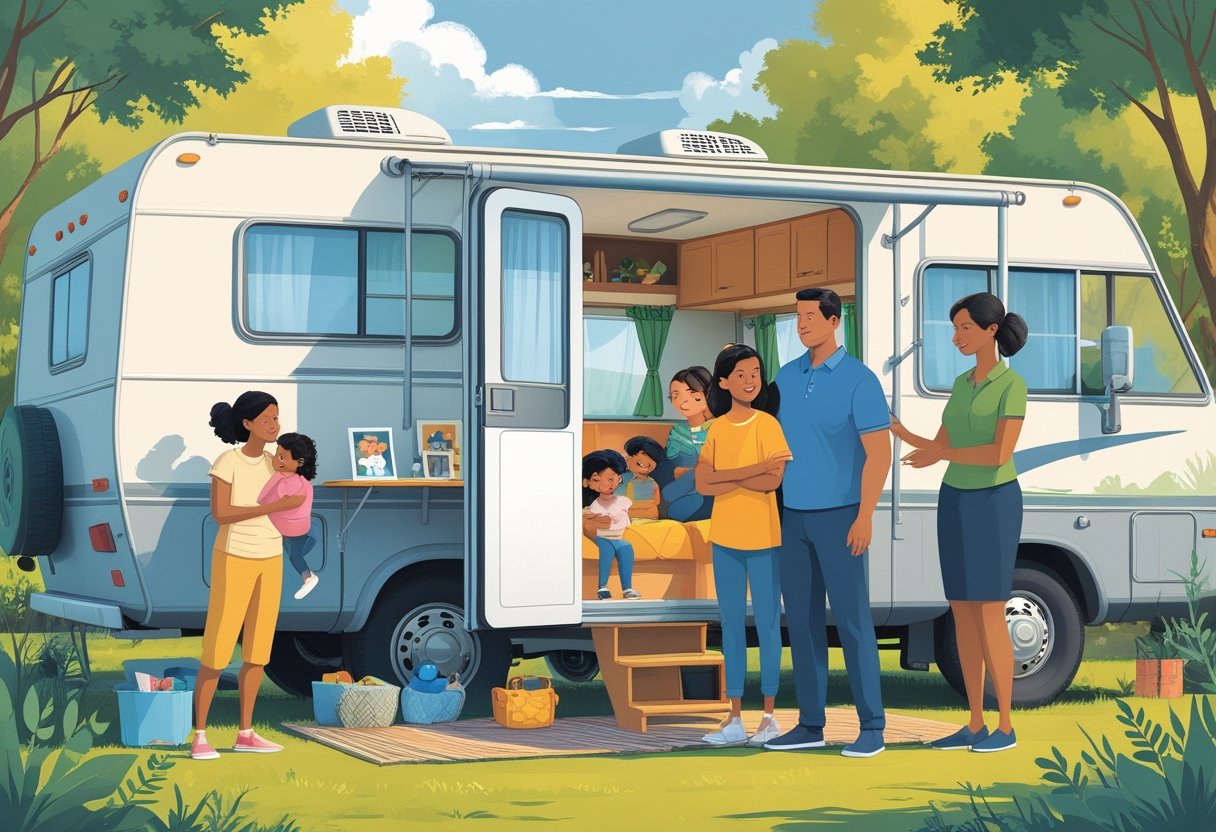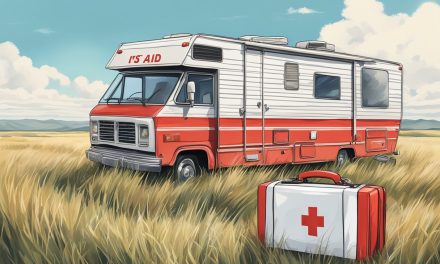Would you like to save this article?
Many families choosing the RV lifestyle worry about Child Protective Services taking their children away. Living in an RV does not automatically give CPS the right to remove your child from your care.
The agency focuses on whether your child’s basic needs are being met, not the type of home you live in.
CPS can only take action when there is proof of neglect, abuse, or immediate danger to your child’s safety. The key is making sure your RV provides a clean, safe environment with proper utilities, sanitation, and basic necessities.
Poor living conditions, lack of resources, or health hazards could trigger an investigation. Understanding what CPS looks for during an investigation helps you prepare and protect your family.
You can take steps to prove your RV is a stable home by keeping maintenance records, ensuring proper utilities, and documenting your child’s health and education.
Key Takeaways
- CPS cannot remove children based solely on living in an RV if basic needs are met
- Investigators evaluate RV homes using the same safety standards as traditional houses
- Proper documentation and maintenance records help prove your RV is a safe environment
Legal Standards for CPS Intervention
Child Protective Services must follow specific legal rules when deciding whether to remove a child from their parents. Court orders play a key role in most removal cases, while parents keep certain rights throughout the process.
When Child Protective Services Can Remove a Child
CPS can only take your child when they have clear evidence of danger or harm. The agency must prove that your child faces immediate risk.
Common reasons for removal include:
- Physical abuse or neglect
- Sexual abuse
- Drug or alcohol abuse by parents
- Unsafe living conditions
- Abandonment
- Medical neglect
Living in an RV alone is not grounds for removal. CPS must show that your RV creates specific dangers for your child.
The agency looks at basic needs like food, water, shelter, and safety. They also check if your child can access school and medical care.
CPS workers must document their concerns with photos and written reports. They cannot remove your child based on personal opinions or bias against your lifestyle.
Role of Court Orders in CPS Cases
Most child removals require a court order. CPS must ask a judge for permission before taking your child in non-emergency situations.
Emergency removals can happen without a court order if:
- Your child faces immediate danger
- There is no time to get a judge’s approval
- CPS has reasonable belief of serious harm
After an emergency removal, CPS must go to court within 24-48 hours. A judge will decide if the removal was legal and necessary.
You have the right to attend all court hearings about your case. The judge will review evidence and hear from both sides before making decisions.
Overview of Parental Rights
You keep most of your parental rights during a CPS investigation. The agency cannot take away these rights without following proper legal steps.
Your key rights include:
- Right to legal representation
- Right to visit your child
- Right to challenge CPS decisions in court
- Right to refuse entry without a warrant
- Right to remain silent during interviews
CPS cannot terminate your parental rights quickly. This process takes months or years and requires multiple court hearings.
You can work with CPS to address their concerns and get your child back. Following their safety plan and completing required services helps show you are a fit parent.
How Living in an RV Is Evaluated by CPS
CPS investigators use specific criteria to determine if your RV living situation meets child welfare standards. They focus on basic needs, safety hazards, legal compliance, and access to essential services.
Assessing Basic Needs and Safety in an RV
CPS evaluates whether your RV provides the fundamental requirements for child welfare. They check if you have running water, electricity, and proper heating or cooling systems.
Space requirements are a major concern. Children need adequate room for sleeping, playing, and storing belongings.
CPS looks for overcrowding issues that could affect a child’s development. Sleeping arrangements must provide privacy and comfort.
Children typically need separate sleeping areas from adults. This can be challenging in smaller RVs but can be addressed with proper curtains or dividers.
Structural safety is examined closely. CPS checks for broken windows, loose railings, or damaged floors.
They also look for proper ventilation to prevent carbon monoxide buildup. Your RV must be in good working condition.
Broken appliances, leaking pipes, or faulty electrical systems can create safety hazards that concern CPS investigators.
Sanitation and Environmental Risks
Sanitation standards are strictly evaluated in RV living situations. CPS checks that you have access to clean water for drinking, cooking, and bathing.
Your waste management system must work properly. This includes both black water and gray water systems.
Backup or overflow creates health risks that CPS considers serious. Environmental dangers include mold, pests, or chemical exposure.
Poor ventilation can lead to moisture problems and mold growth. CPS looks for these issues during inspections.
Cleanliness of the living space matters significantly. Dirty dishes, garbage buildup, or unsanitary conditions can trigger CPS concerns about neglect.
Food storage and preparation areas must meet health standards. CPS checks that you can safely store adequate food and prepare meals for your children.
Location and Legal Zoning
Legal parking affects how CPS views your living situation. Parking in areas not zoned for residential use can create problems with local authorities.
CPS considers whether your location provides stability for your children. Constantly moving or staying in unsafe living conditions raises red flags about housing security.
Neighborhood safety is evaluated based on crime rates and environmental hazards. Parking near industrial areas or high-crime zones can concern investigators.
Access to utilities becomes complicated in illegal parking situations. CPS needs to see that you can maintain consistent power, water, and sewer connections.
Local ordinances about RV living vary widely. Some areas prohibit full-time RV residence, which can complicate your legal standing with CPS.
Consistent Access to Education and Healthcare
School enrollment must be maintained regardless of your living situation. CPS verifies that your children attend school regularly and receive proper education.
Healthcare access requires you to maintain medical care for your children. This includes regular checkups, vaccinations, and emergency medical services.
Transportation to schools and medical appointments is crucial. CPS evaluates whether your RV lifestyle interferes with these essential services.
Address stability for school districts can be challenging. Some districts require permanent addresses, making RV living more complicated for educational continuity.
Emergency services access must be available. CPS considers whether your location allows ambulances, fire trucks, or police to reach you quickly if needed.
Neglect, Abuse, and Unsafe Living Conditions
CPS focuses on three main areas when evaluating RV living situations: neglect occurs when basic needs go unmet, abuse involves harm to the child, and unsafe conditions create immediate danger to health or safety.
Defining Neglect and Child Abuse
Neglect happens when you fail to provide basic needs for your child. This includes food, clean water, medical care, and proper shelter.
In an RV, neglect might look like no working bathroom, spoiled food, or no heat in cold weather. Physical abuse involves hitting, shaking, or hurting your child.
Sexual abuse includes any inappropriate contact. Emotional abuse means constant yelling, threats, or putting your child down.
Medical neglect occurs when you don’t get medical care for serious health problems. This includes skipping doctor visits, not giving needed medicine, or ignoring injuries.
CPS looks at whether your actions put your child at risk of harm. They consider your child’s age and needs.
A baby needs different care than a teenager.
Common Signs of Unsafe Environments
Environmental dangers in RVs include broken windows, exposed wires, or gas leaks. CPS checks if your RV has working smoke detectors and carbon monoxide alarms.
Sanitation problems are red flags for CPS. These include:
- No clean water for drinking or washing
- Broken toilet or no bathroom access
- Trash piled up inside or outside
- Mold or pest problems
- Strong chemical smells
Structural issues that create danger include holes in floors, broken steps, or doors that don’t lock. CPS also looks at overcrowding if too many people live in a small space.
Lack of basic utilities like electricity, heat, or air conditioning can be problematic. Your RV needs to protect your child from extreme weather.
Impact of Substance Abuse and Domestic Violence
Substance abuse creates serious safety risks for children in RVs. Using drugs or drinking too much alcohol affects your ability to care for your child properly.
CPS considers it neglect when substance use leads to poor judgment or dangerous situations. This includes leaving your child alone, not providing food, or driving under the influence.
Domestic violence puts children at high risk of physical and emotional harm. Fighting, yelling, or threats create fear and stress for kids.
The small space of an RV makes domestic violence more dangerous. Your child cannot easily escape or hide from violence.
CPS may remove children immediately if they witness violence or if an abusive partner has access to the RV. They also look at your ability to protect your child from harm.
Protecting Your Family and Proving a Stable Environment
Good documentation and proper maintenance help show CPS that your RV provides a stable environment for your children. Meeting all custody requirements while living in a camper takes careful planning and record-keeping.
Maintaining Records and Documentation
Keep detailed records of your child’s care and living conditions. This documentation proves you provide a stable environment even while living in a camper.
Essential documents to maintain:
- Medical records and vaccination history
- School enrollment papers and attendance records
- Proof of permanent address or mail forwarding service
- Insurance policies for health and RV coverage
- Financial records showing stable income
Take photos of your RV’s interior and exterior monthly. Show clean living spaces, working appliances, and safety features.
Date stamp all pictures for your records. Document your child’s routine activities.
Keep calendars showing school days, medical appointments, and social activities. This proves stability in your child’s daily life.
Store copies of all important papers in waterproof containers. Keep digital backups on cloud storage.
Quick access to these documents helps during any CPS investigation.
Demonstrating RV Safety and Routine Maintenance
Regular maintenance shows CPS that your RV is a safe home for children. Keep detailed service records and fix problems quickly.
Key safety areas to maintain:
- Working smoke and carbon monoxide detectors
- Proper ventilation systems
- Safe electrical connections
- Clean water supply and waste management
- Secure furniture and storage areas
Schedule professional inspections every six months. Get written reports from certified RV technicians.
These papers prove your home meets safety standards. Check all safety equipment monthly.
Test fire extinguishers, first aid supplies, and emergency exits. Replace batteries in detectors regularly.
Keep maintenance logs showing all repairs and upgrades. Note dates, costs, and who did the work.
This record proves you take care of your family’s home.
Meeting Custody Agreement Requirements
Your custody agreement may have special rules about living in a camper. Follow all requirements exactly to avoid problems with CPS or family court.
Review your custody papers carefully. Look for any limits on where your child can live.
Some agreements require court approval before moving to an RV.
Common custody requirements:
- Stable address for school enrollment
- Adequate sleeping space for children
- Safe neighborhood or campground location
- Access to medical care and emergency services
Notify the other parent and court if required. Some states need written notice before changing your child’s living situation.
Follow all legal steps to avoid violations.
Work with your lawyer if custody rules seem unclear. They can help you understand what “stable environment” means in your case.






